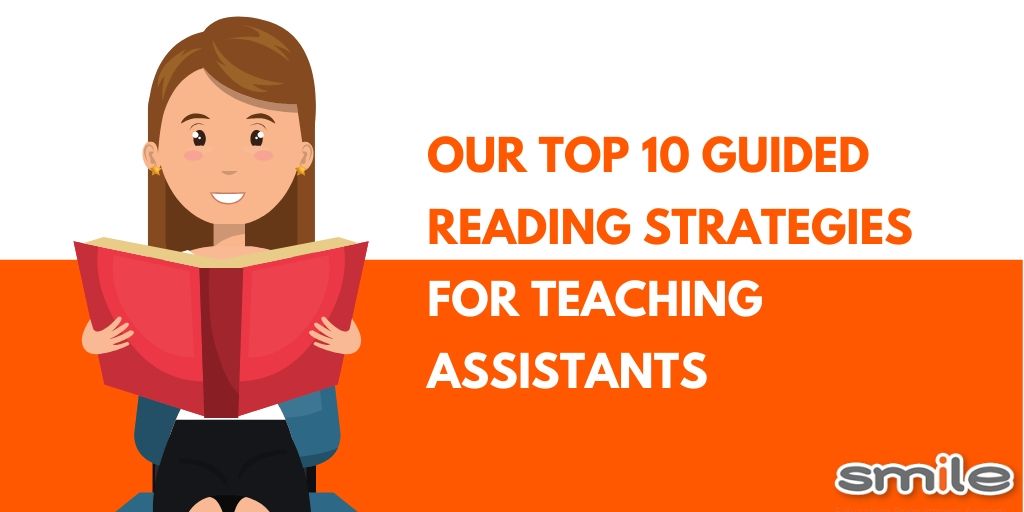Blog
Are you a supply teacher or teaching assistant looking for some help and advice? If so, you are in the right place. Our blogs offer tips and tricks on everything from classroom management to interview tips and support, along with day in the life case studies from real supply teachers, ECTs and cover supervisors. They also give you an insight into what working for Smile is like, the ways which we support local communities and charities and the training and events that we offer.
For more good stuff like this, follow us on social media - you can find us on Facebook, Instagram, Twitter and LinkedIn. Or pick up the phone and give us a call.
As a teaching assistant, you will be required to lead guided reading sessions with individual children and small groups. While this might sound easy, keeping students engaged is easier said than done.
But don’t worry, we have picked the brains of the many Teaching Assistants we work with and compiled a list of helpful ideas. Have a look at some of the strategies we’ve suggested.
1. Character voice cards
Making learning fun is a great skill to have. Character voice cards are a great way to add a little humour into reading which helps to make it more enjoyable - not just for the students but for you too!
So, how does this work? Create some cards with different pictures on them (a pirate, a princess, an angel) and place them in the middle of the table, then ask the students to choose one at random and then read the next page in this voice.
2. Take the children’s interest into account
An interested child is an engaged child. With that said, it is important to take the child’s or children’s interest into account when choosing reading material. Our top tip would be to let the children pick the story for themselves. This way you can be sure that they are interested.
3. Have other materials handy
Books are not the only things that can be read. To mix it up, try using magazines, comics or even looking at websites. You could even look to everyday items for inspiration and ask students to read out the packaging on a packet of crisps or make a game of it, by placing words around the room and asking the children to find them. Remember reading doesn’t have to be boring!
4. Create comfy and inviting reading spaces
Your reading space should be comfortable and inviting. It should be different from the main teaching area, that way children will view the area to be more inviting. The brighter and more interactive the area is the more likely children will show willing. Think bean bags!
5. Pair up older and younger children
Getting children to work together is a really great learning strategy which can be mutually beneficial. One idea you could consider suggesting is setting up a buddy system with some of the older pupils. This gives older children the opportunity to enjoy some responsibility and is more likely to keep the younger ones engaged.
6. Keep the library fresh
If you want to keep children engaged in reading, an up-to-date library is a must. After all, a stagnant library is an unused library. Speak with the class teacher about adding some new books every few months, you may find that you can get them very cheaply from places like eBay or even your local charity shop.
When you are adding new additions to the library, be sure that there is a good variety of genres and reading levels to suit the ability and needs of the class.
7. Use flashcards
Flashcards are a great resource no matter how old you are! What’s even better is that there are hundreds of different ways that they can be used. For example, you could pull some keywords from the book you are reading and ask the students to put it in a sentence.
8. Start discussions and spin-off activities
Create your own mini book club by asking your students to all read the same book and then come together and discuss it - this is the perfect half term task as it gives students the time to read it.
When you next get together ask the childrens questions about the book such as:
- What was your favourite part?
- Who was your favourite character and why?
- Did you like the ending?
This will then open up a dialogue and get them talking about it with one another which will further solidify their learning.
9. Use audiobooks
Audiobooks are a great way to reinforce the relationship between sound and meaning in student’s minds. Thanks to the internet there are lots of free audiobooks out there which you could make use of.
Using audiobooks can also make the reading sessions more interesting as they add another dimension to the learning.
10. Make use of technology
The internet is a wonderful tool (when used correctly!) so be sure to make use of it. There are lots of fun, engaging and interactive programmes which exist primarily to help children with their reading. The applications allow children to get involved in stories, change the outcomes and earn rewards as they go. Even better they are colourful and have jazzy sound effects that will definitely keep them engaged.
If you would like to become a teaching assistant and work with Smile Education, then send us your CV today or take a look at our latest vacancies.
Add a comment:
Blog Categories












